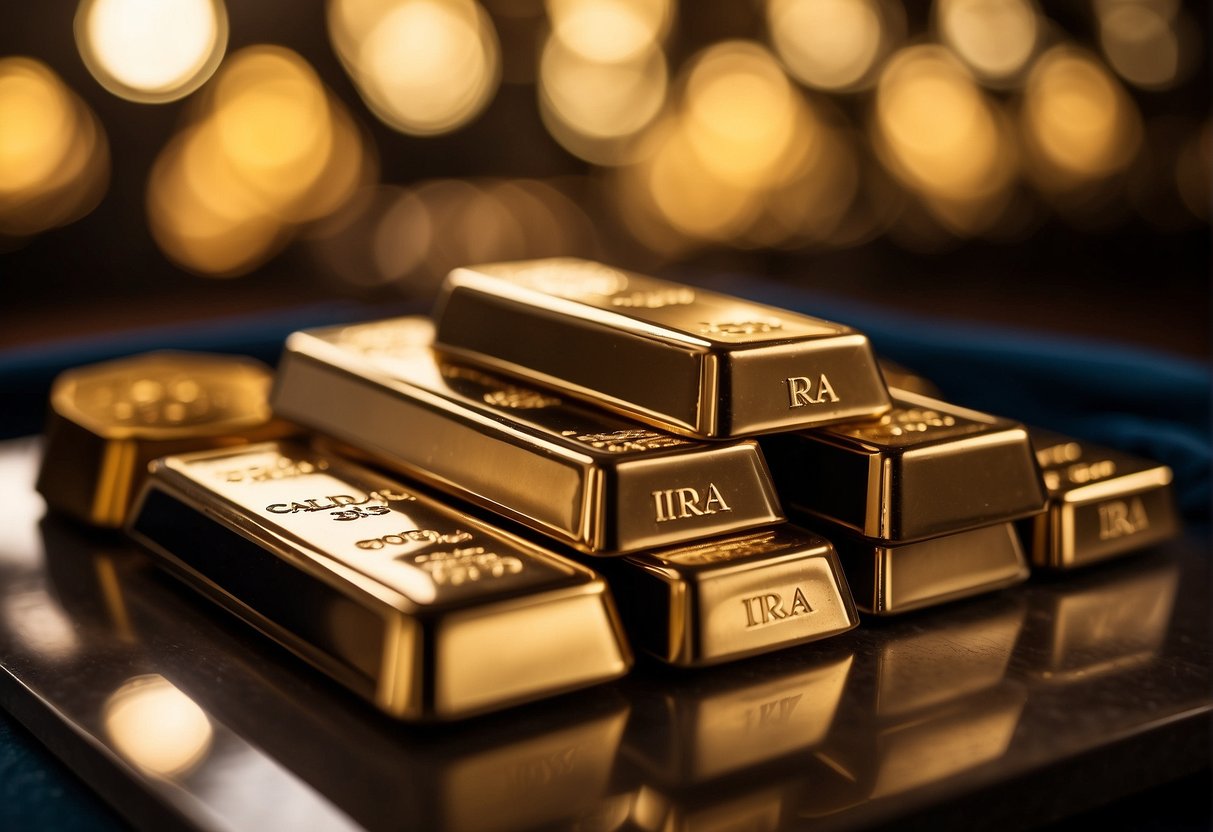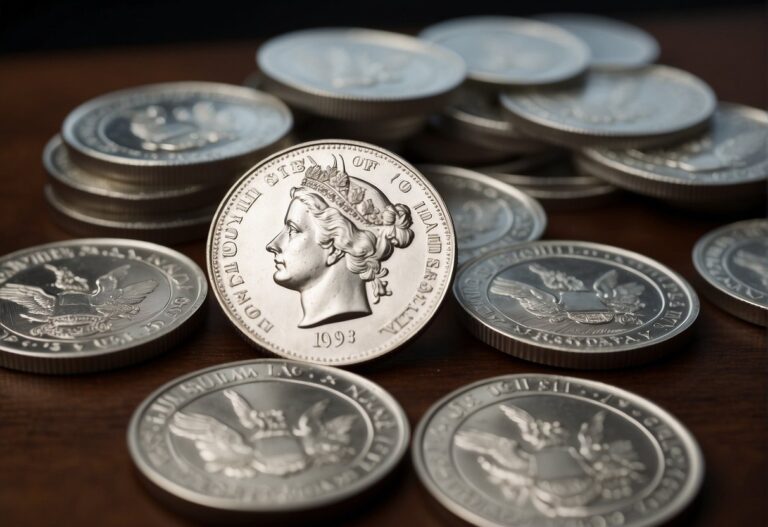A Gold IRA is a specialized Individual Retirement Account (IRA) that allows investors to diversify their retirement savings by investing in physical precious metals. Unlike traditional IRAs, typically composed of stocks, bonds, or mutual funds, Gold IRAs are backed by tangible assets like gold bullion, coins, or other approved precious metals.
These accounts are known for providing a hedge against economic volatility and inflation.
Setting up a Gold and Silver IRA involves selecting a custodian specializing in these accounts and complies with IRS guidelines related to precious metals IRAs.
Investors can fund their Gold IRAs through a rollover from an existing retirement account or by making a direct deposit.
Once funded, the custodian helps purchase the eligible precious metals, which must meet specific purity and fineness standards to qualify for a Gold and Silver IRA.
The physical metals are then stored in a secure, insured depository.
Key Takeaways
- A Gold IRA permits holding physical gold and other precious metals within a retirement account.
- Investors need a specialized custodian to set up and manage a Gold IRA under IRS guidelines.
- Physical metals in a Gold and silver IRA must meet defined purity standards and are securely stored.
Understanding Gold and Silver IRAs

A Gold IRA is an Individual Retirement Account that allows one to invest in physical gold and other approved precious metals. This type of IRA offers a conservative investment strategy for diversifying their retirement portfolio.
Gold IRA Basics
A Gold IRA is a Self-Directed IRA specifically for holding gold and other precious metals. These accounts are governed by the same rules and contribution limits as conventional IRAs, with the critical difference being the nature of the investment.
The Internal Revenue Service (IRS) sets stringent regulations for Gold IRAs, notably regarding what types of metals can be included and how they should be stored.
Benefits of a Gold IRA
Investors choose Gold IRAs for their potential to hedge against inflation and economic volatility. Gold often maintains its value over time, making it an attractive option for long-term wealth preservation within a retirement account.
The tax advantages of a traditional or Roth IRA, such as tax-deferred or tax-free growth, also apply to Gold IRAs, providing a favorable environment for investment growth.
How Does A Gold IRA Work?
To establish a Gold IRA, an investor must open a Self-Directed IRA with a custodian specializing in this type of investment. The individual then funds the account and selects the precious metals to purchase, and the custodian facilitates the buying and safe storage of these assets.
The metals must be stored in an IRS-approved depository to meet the legal requirements. Withdrawals follow the same age and distribution rules as other IRAs, with specific tax implications depending on whether it is a traditional or Roth IRA.
Types of Gold IRAs

Gold Individual Retirement Accounts (IRAs) allow investors to diversify their retirement portfolios with precious metals. These accounts come in various forms, each with specific tax implications and rules regarding contributions.
Traditional Gold IRA
A Traditional Gold IRA is a self-directed IRA that allows individuals to invest in gold using pre-tax income. Contributions to a Traditional Gold IRA may be tax-deductible, reducing the individual’s taxable income for the year funds are contributed. Taxes are, however, due upon withdrawal of the assets, typically during retirement when the individual may be in a lower tax bracket.
- Tax: Pre-tax contributions; taxed on withdrawals
- Contribution Limits: Subject to annual IRA limits
Roth Gold IRA
In contrast to a Traditional IRA, a Roth Gold IRA involves after-tax contributions, but the advantage is that the withdrawals during retirement are generally tax-free. It is an attractive option for those who anticipate being in a higher tax bracket in the future or for those who prefer tax-free withdrawals.
- Tax: After-tax contributions; tax-free withdrawals
- Contribution Limits: Subject to annual IRA limits, with income restrictions for eligibility
SEP Gold IRA
A SEP Gold IRA is a Simplified Employee Pension plan that allows employers, including self-employed individuals, to contribute to their own and their employees’ retirement. Contributions to a SEP Gold IRA are tax-deductible for the business, and the contribution limits are significantly higher than traditional or Roth IRAs.
- Tax: Employer contributions are tax-deductible
- Contribution Limits: Higher than Traditional and Roth IRAs; up to 25% of compensation or a specific annual maximum
In each of these accounts, the IRS has specific requirements for the purity and storage of the physical gold, underscoring the importance of understanding the rules associated with gold investing for retirement.
Gold IRA Eligible Precious Metals

Investors considering a Gold IRA should know that only specific precious metals are allowed. These metals must meet purity requirements and are typically held in coin or bullion form at an IRS-Approved Depository.
Gold and Silver
Gold eligible for a Gold IRA must be 99.5% pure, while silver must have a fineness of 99.9%. Popular choices include the American Gold Eagle, an exception to the purity rule, and the American Silver Eagle. It is important to note that collectible coins typically only qualify if the IRS explicitly sanctions` them.
Eligible Gold Coins:
- American Gold Eagle
- Canadian Gold Maple Leaf
- Austrian Gold Philharmonic
- Australian Kangaroo/Nugget
Eligible Silver Coins:
- American Silver Eagle
- Canadian Silver Maple Leaf
- Austrian Silver Philharmonic
- Australian Silver Kookaburra
Platinum and Palladium
For platinum and palladium, the IRS stipulates a purity of 99.95%. These metals are less common in IRAs but can provide diversification benefits. Eligible products include the American Platinum Eagle and the Canadian Palladium Maple Leaf.
Eligible Platinum Coins:
- American Platinum Eagle
- Canadian Platinum Maple Leaf
Eligible Palladium Coins:
- Canadian Palladium Maple Leaf
All precious metals must be in the form of coins or bullion and be held by an IRS-Approved Depository to ensure safety and compliance with IRS regulations.
Setting Up a Gold IRA
Setting up a Gold IRA requires careful selection of a custodian and metals dealer and understanding the setup fees associated with creating and funding your retirement portfolio.
Choosing a Custodian
A custodian is a financial institution that holds and safeguards the physical gold in a Gold IRA. They are responsible for ensuring that the gold in the IRA complies with IRS standards. Investors should choose a reputable custodian that offers transparent pricing structures.
Some custodians might charge a setup fee and yearly storage fees. It’s crucial to compare these costs and consider how they might affect the long-term growth of one’s retirement portfolio.
Selecting a Metals Dealer
The role of a metals dealer is to facilitate purchasing IRS-approved metals to be held in the Gold IRA. They should be selected based on their reliability, expertise in the precious metals market, and the variety of metals they offer.
Pricing can vary significantly from one dealer to another, so it’s essential to conduct thorough research to ensure competitive pricing and authenticity of the metals purchased.
Funding Your Gold IRA
Once the custodian and metals dealer have been chosen, funding the Gold IRA is the next step. This can be done through a transfer or rollover from an existing IRA or by directly depositing the new Gold IRA account.
One should always review the terms and conditions related to the funding process to ensure they are making the most of their retirement portfolio without incurring potential tax penalties.
Gold IRA Investment Options

Investors have various options and strategies to enhance their portfolio through precious metals when considering a Gold IRA. Each decision, from the types of metals to the time horizon of the investment, can impact the IRA’s performance.
Diversifying with Precious Metals
Portfolio diversification is a critical strategy in mitigating risk. Investors in a Gold IRA can do this by including gold, silver, platinum, and palladium in their accounts. They might choose to balance holdings with traditional stocks, bonds, and mutual funds.
Precious metals often move independently of market cycles that affect traditional securities, providing a counterbalance during volatile periods.
Understanding Storage Options
Securing physical assets is a critical component of a Gold IRA. Investors need to understand that the IRS mandates using approved depositories to safeguard physical precious metals safely.
These solutions range from segregated storage, which keeps an investor’s metals separate, to non-segregated, where assets are commingled with others but are still fully allocated to the investor.
Long-Term vs Short-Term Investing
Investors should consider their investment horizon when selecting precious metals for a Gold IRA. For those with a long-term perspective, gold and other metals can hedge against inflation and economic uncertainty. On the other hand, those looking at short-term gains must be aware of metals’ volatility and might need to be more active in managing their investment to respond to market fluctuations.
Gold IRA Rules and Regulations
Specific IRS regulations govern Gold Individual Retirement Accounts (IRAs), have defined contribution limits, and maintain particular distribution policies. Understanding these aspects is crucial to ensure compliance and optimize the benefits of a Gold IRA.
IRS Regulations
The Internal Revenue Service (IRS) sets forth regulations for Gold IRAs to ensure proper handling of precious metals within retirement accounts. All metals within a Gold IRA must meet the IRS standards for purity, often requiring gold to be 99.5% pure.
Furthermore, these accounts are self-directed, requiring investors to work with an approved custodian. The IRS-approved precious metals must be stored in a secure depository to comply with tax rules.
Gold IRA Contribution Rules
Gold IRAs adhere to the same annual contribution limits as traditional and Roth IRAs. For the tax year 2023, the contribution limit is $6,000, or $7,000 for individuals aged 50 and over.
These contributions to a Gold IRA can be made in cash and then used to purchase gold, or in some cases, physical gold can be transferred directly.
All contributions must be made in keeping with annual deadline regulations, typically April 15th of the following year.
Gold IRA Distribution Policies
Distributions from a Gold IRA fall under tax-deferred growth until a withdrawal is made. When investors reach the age of 59½, they are eligible to take distributions without penalties. However, taking distributions before this age may lead to a 10% early withdrawal penalty.
Gold IRA holders must also adhere to Required Minimum Distributions (RMDs) starting at age 72, with the amounts calculated based on the account balance and the account holder’s life expectancy as determined by the IRS.
Failure to take RMDs can result in hefty penalties, up to 50% of the amount that should have been withdrawn.
Gold IRA Tax Implications

When considering a Gold IRA, it’s crucial to understand the tax implications that can affect one’s retirement savings. These implications include potential tax benefits and possible penalties that come with the territory of this type of retirement account.
Tax Benefits of Precious Metals IRAs
Gold IRAs offer certain tax advantages explicitly tailored for retirement savings. Often structured as Traditional or Roth IRAs, they differ in tax treatment. With a Traditional Gold IRA, the contributions may be made with pretax dollars, allowing the tax-deferred growth of assets until withdrawals are made during retirement.
This means the account holder may pay taxes on their withdrawals at their tax rate during retirement, which is typically lower than their working-years tax rate.
In contrast, a Roth Gold IRA is funded with after-tax dollars. The significant advantage is that qualified distributions are tax-free since the taxes are paid upfront.
For detailed information on tax implications, you can look at an in-depth guide on taxes and your Gold IRA.
Understanding Silver IRA Tax Penalties
The IRS imposes specific rules on Gold IRAs to ensure they are used for retirement savings. If an account holder takes an early distribution before the age of 59½, it may be subject to a 10% penalty in addition to the ordinary income tax.
This penalty is in place to discourage using these funds for purposes other than retirement. There are, however, some exceptions to this penalty, such as a first-time home purchase or qualifying educational expenses.
It is essential to understand these rules to avoid unexpected penalties. For information about regulations changing in 2023, one can review the updates regarding Gold IRA tax rules.
Silver IRA Potential Risks and Considerations

When considering a Gold IRA, investors should be aware of the potential risks and considerations, such as market volatility, the structure of fees and costs, and the personal risk tolerance assessment. These factors are critical to understanding the overall investment landscape of Gold IRAs.
Market Volatility
The price of gold can be highly volatile, influenced by numerous global factors, including economic events, market speculation, and currency values. Investors should recognize that the value of their Gold IRA can fluctuate, sometimes significantly, due to these market dynamics.
Silver IRA Fees and Costs
Investing in a Gold IRA typically involves higher fees when compared to traditional IRAs. These can include:
- Setup Fees: Initial cost to establish the IRA account.
- Storage Fees: Ongoing costs for the secure storage of physical gold.
- Custodian Fees: Annual costs paid to the custodian managing the IRA.
It’s essential to review fee structures carefully, as they can impact the long-term value of the investment.
Assessing Risk Tolerance
Each investor’s risk tolerance is unique and should be carefully evaluated before investing in a Gold IRA. Considering one’s investment horizon and how comfortable they are with the possible fluctuations in gold prices is fundamental in determining if a Gold IRA aligns with one’s financial goals.
Managing Your Gold IRA

Effective management of a Gold IRA involves careful monitoring and adjustments that blend financial savvy with strategic foresight. Investors should pay close attention to portfolio balance, assess performance regularly, and seek expert advice to optimize the potential of their precious metals investment.
Rebalancing Your Portfolio
Rebalancing is critical for any investor looking to maintain a desired level of risk and return in their Gold IRA. As market values fluctuate, the percentage of gold may deviate from the target allocation, necessitating periodic adjustments. This ensures that diversification is consistent with the investor’s risk tolerance and investment goals.
- Review Allocations Quarterly: Ideally, investors should evaluate their portfolio every three to six months.
- Adjust Proportions: If the value of gold has significantly changed, buying or selling portions of the asset to realign with the initial investment strategy is prudent.
Evaluating Performance
Assessing the performance of a Gold IRA requires more than just tracking the current price of gold. Investors should:
- Look at historical data to understand long-term trends.
- Compare returns against benchmarks and alternative assets to determine relative performance.
- Consider factors like liquidity, which can affect the ease of adjusting holdings.
A robust analysis includes various metrics:
- Annualized Returns: These provide the average yearly performance.
- Comparison to Inflation Rates: Gold is often a hedge against inflation, so its value should ideally outpace the rise in the cost of living.
Consulting Financial Advisors
Financial advisors are integral in guiding investors through the complex landscape of Gold IRAs. They offer:
- Expert Analysis: Advisors provide insights into market trends, helping investors make informed decisions.
- Personalized Strategies: Each investor has a unique financial situation; advisors tailor recommendations accordingly.
Engaging with a financial advisor experienced in precious metals can help ensure that investment strategies align with the investor’s objectives, risk tolerance, and time horizon.
Anyone managing a Gold IRA must clearly understand the market and regulatory considerations, which a competent advisor can provide.
Selecting a Gold IRA Provider
When choosing a provider for a Gold IRA, investors should thoroughly compare companies and investigate each provider’s transparency and track record. Making an informed decision is crucial for the security of assets and compliance with IRS regulations.
Comparing Silver IRA Companies
When comparing Gold IRA Companies, investors should look at various criteria, including the types of precious metals offered, the fees charged, and the company’s expertise in managing Gold IRAs. For example, firms such as Noble Gold and Goldco are specialized providers offering various gold and silver investment options tailored for IRAs. It’s advised to create a comparison table, like the one below, to evaluate each company:
| Company Name | Fees | Types of Metals Offered | IRA Services |
|---|---|---|---|
| Noble Gold | X | Gold, Silver | Full-service |
| Goldco | Y | Gold, Silver, Platinum | Full-service |
Provider Transparency and Track Record
The track record of a Gold IRA provider can reveal their reliability and expertise. Prospective clients should seek out firms with a proven history of ethical practices and transparent communications.
Factors such as the time in business, customer reviews, and accreditation by industry watchdogs can provide insight into a provider’s reputation.
For instance, a brokerage firm acting as a Custodian must demonstrate a clear history of regulatory compliance and custodial responsibilities. Investors should have easy access to this information and feel confident in the provider’s ability to manage their IRA effectively.
Companies like Goldco often provide extensive resources and information to assure transparency, helping investors understand what they are investing in and how their Gold IRA will be managed.
Gold IRA Frequently Asked Questions

In retirement planning, understanding a Gold IRA’s structure, tax implications, and comparison to other investment vehicles is crucial for informed decision-making.
How does investing in a Gold IRA compare to holding physical gold?
Investing in a Gold IRA allows individuals to hold precious metals within a retirement account, thereby offering the tax advantages of an IRA alongside the stability perceived in physical gold. However, the investor needs direct access to the physical gold, which must be stored in a secure depository.
Can you explain the differences between a Silver IRA and a traditional 401k?
A traditional 401k typically holds stocks, bonds, and mutual funds, while a Gold IRA holds physical precious metals. One’s 401k is often limited to the investment options their employer provides.
In contrast, a Gold IRA offers autonomy in investment choice, especially for those interested in including gold in their retirement plan.
What are the potential benefits of adding gold to an IRA?
Gold is often seen as a hedge against inflation and currency devaluation, making it a potentially beneficial component of a retirement portfolio. A Gold IRA may provide security during market volatility, as gold historically holds its value over time.
Do you know if there are any specific tax considerations to be aware of with Silver IRAs?
Gold IRAs follow the same tax rules as traditional IRAs, meaning contributions are tax-deductible, and capital gains are not taxed until the metal is sold or distributed. However, special rules apply to the types of precious metals that can be included and how they’re stored.
How does a Gold IRA fit into a diversified retirement investment strategy?
Incorporating a Gold IRA into a retirement plan can diversify one’s investment portfolio. Since gold often moves inversely to the stock market, it can serve as a counterbalance during times of market downturns.
What are the initial and ongoing costs associated with opening and maintaining a Gold IRA?
Opening a Gold IRA involves several fees, such as setup fees, storage fees for the physical gold, and possibly seller’s fees. There are ongoing costs, including annual maintenance fees, which vary depending on the custodian and the value of the gold stored.



